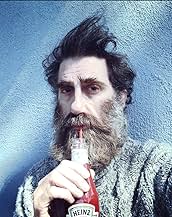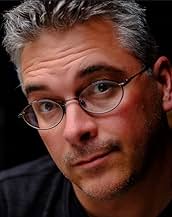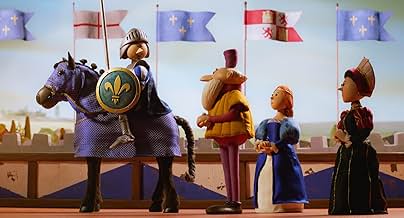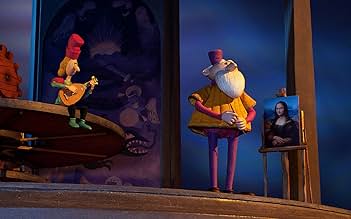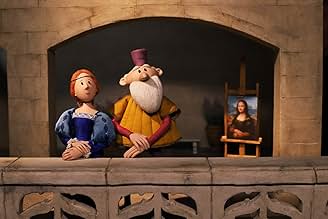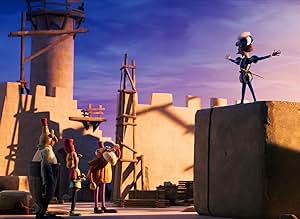अपनी भाषा में प्लॉट जोड़ेंInventing flying contraptions, war machines and studying cadavers, Leonardo da Vinci tackles the meaning of life itself with the help of French princess Marguerite de Nevarre.Inventing flying contraptions, war machines and studying cadavers, Leonardo da Vinci tackles the meaning of life itself with the help of French princess Marguerite de Nevarre.Inventing flying contraptions, war machines and studying cadavers, Leonardo da Vinci tackles the meaning of life itself with the help of French princess Marguerite de Nevarre.
- निर्देशक
- लेखक
- स्टार
- पुरस्कार
- 1 जीत और कुल 3 नामांकन
Daisy Ridley
- Marguerite
- (वॉइस)
Matt Berry
- Pope Leo X
- (वॉइस)
Aaron Heffernan
- Crowd
- (वॉइस)
Ben Stranahan
- Page
- (वॉइस)
Jim Capobianco
- The Physician
- (वॉइस)
- …
Gaspard Flory
- Crowd
- (वॉइस)
Marion Charrier
- Annette
- (वॉइस)
Janan Abir
- Crowd
- (वॉइस)
फ़ीचर्ड समीक्षाएं
I loved this film. I took my son whose 10 to see this as well and he really liked it as well. Interesting the combination of stop motion animation and hand drawn animation and water color painting is just remarkable in this interesting combination. It story of daVinci in his final days is inspiring and touching and also sending a message to kids don't be afraid to think for yourself and stand up for what you believe in. We need more material for kids like this and let them know it's ok to be who you are. Too bad this will probably get lost in the shuffle of other movies and it's a very small production company thst put it out. Highly recommend for a thought provoking non cgi kid film.
It's 1516 Rome. Leonardo da Vinci is looking to skies. He has a complicated relationship with Pope Leo X. He befriends Marguerite who is the sister of French king Francis I. They put on a show to bring a new peaceful culture to Emperor Charles V and King Henry VIII.
This is an animated biopic of Leonardo da Vinci. The animation is a mix of stop-motion and hand-drawn although they may have used CGI. The stop-motion reminds me of the old Rankin/Bass specials. This doesn't have a three act story structure. It is more a flat temporal flow. In that way, it is slightly educational while randomly entertaining. It doesn't give any drama. It's cute.
This is an animated biopic of Leonardo da Vinci. The animation is a mix of stop-motion and hand-drawn although they may have used CGI. The stop-motion reminds me of the old Rankin/Bass specials. This doesn't have a three act story structure. It is more a flat temporal flow. In that way, it is slightly educational while randomly entertaining. It doesn't give any drama. It's cute.
Loved it. A VERY good tale of a misunderstood genius using his inquisitiveness to push forward the world or science, up against cynicism, ego, power and the battle with the all-powerful church which saw science as undermining to faith (on which its influence was based). Could have been set... today. Most suited to older children and definitely for adults with a interest in science, arts, innovation and the battle of discovery over power. Some powerful messages in an beautiful animation. It's a lovely mixture of humour, coupled to an authentic look at probably one of the most important stories in our scientific evolution, the work from which still influences today. Congratulations on being bold... just like Leonardo!
Weird negative quote on here about Italians getting English accents. Actually drives me nuts that so many films when aimed at an English-speaking audience have accents that I can't even understand or follow. This one was easy to listen to and the voices suited. Congratulations!!
Weird negative quote on here about Italians getting English accents. Actually drives me nuts that so many films when aimed at an English-speaking audience have accents that I can't even understand or follow. This one was easy to listen to and the voices suited. Congratulations!!
The insatiably curious and headstrong inventor Leonardo da Vinci leaves Italy to join the French court. Leonardo da Vinci spent the last three years of his life in Amboise, France. He arrived there in the autumn of 1516, having accepted an invitation from King Francis I and his mother Louise of Savoy, who welcomed him with open arms at the Château d'Amboise, the young monarch's favourite residence. In 1515, the French king invited Leonardo to the royal summer home, Château du Clos Lucé, near Amboise. There, Leonardo carries out a feverish activity: inventing flying contraptions, war machines, studying cadavers and the human body. Leonardo da Vinci tackles the meaning of life itself .There, joined in his adventure by the audacious princess Marguerite, Leonardo will uncover the answer to questions about life. Imagination takes flight !. What is the meaning of it all?
An acceptable and passable Stop-motion movie, being nominated for the best animated feature film at the 2023 Annecy Festival. Here the last years of Leonardo's life are developed, after having had problems with the Catholic Church, specifically Pope Leo X. The film addresses the meaning of life itself, and the process of building an ideal city, and his relationship with the King of France, Francis I, and especially the friendship with his sister, the French princess Margarita of Navarre. Adding brief appearances by Emperor Charles V of Germany and Henry VIII of England who fight and contend with King Francis I of France. Being written and directed by Jim Capobianca, although the script fails a lot because it does not properly develop the story and becomes somewhat heavy and boring. Capobianco was the original screenwriter of the successful Ratatouille. In the original version it features the voices of Stephen Fry, Daisy Ridley, Matt Berry and Marion Cotillard, among others.
The film is based on biographical facts about Leonardo: In 1516, one year after his coronation, Francis I invited the famous Italian genius Leonardo da Vinci to settle in Amboise. At the age of 64, Leonardo da Vinci, who no longer enjoyed the recognition of Rome and was particularly at odds with the Medici, who preferred Raphael or Michelangelo, accepted Francis I's invitation. For Francis I, Leonardo's presence would bring lustre to the French court and encourage further cultural and artistic development of the French court. The kings of France had always wanted to equal the Italian courts. Leonardo was a sought-after artist but his Italian protector, Giuliano II de Medici, had died prematurely. This allowed da Vinci to accept the invitation of the king of France. Thus, on May 16, after a three-month long journey, after crossing the Alps on mules, he arrived in Amboise, a beautiful town in the Loire Valley, with some of his disciples and three of his favourite paintings: the portrait of the Mona Lisa, the Virgin and Child with Saint Anne and a Saint John the Baptist that he finished painting here. Francis I made the Château de Clos Lucé available to Leonardo da Vinci to live in. He also granted him an income of 700 gold crowns a year, financed his works and only asked him in return for the pleasure of listening to him converse, something he enjoyed almost every day until the genius' death. He also organised numerous parties for the king. Leonardo is also believed to have been involved in the original design of the Château de Chambord, the construction of which began shortly after da Vinci's death. He also brought with him numerous drawings as well as three emblematic and very important paintings for Leonardo: "La Gioconda", "Saint John the Baptist" and "The Virgin, the Child Jesus and Saint Anne", paintings on which he worked for many years. It was his wish to bring these paintings to France. In fact, it was in Amboise that he put the finishing touches to 'Saint Anne', a painting on which he worked for more than 15 years. And shortly before Leonardo's death, Francis I bought the three paintings. That is why today these paintings are in the Louvre, together with two other paintings, 'The Virgin of the Rocks' and 'La Belle Ferronière', that means that one third of da Vinci's pictorial work is in France.
An acceptable and passable Stop-motion movie, being nominated for the best animated feature film at the 2023 Annecy Festival. Here the last years of Leonardo's life are developed, after having had problems with the Catholic Church, specifically Pope Leo X. The film addresses the meaning of life itself, and the process of building an ideal city, and his relationship with the King of France, Francis I, and especially the friendship with his sister, the French princess Margarita of Navarre. Adding brief appearances by Emperor Charles V of Germany and Henry VIII of England who fight and contend with King Francis I of France. Being written and directed by Jim Capobianca, although the script fails a lot because it does not properly develop the story and becomes somewhat heavy and boring. Capobianco was the original screenwriter of the successful Ratatouille. In the original version it features the voices of Stephen Fry, Daisy Ridley, Matt Berry and Marion Cotillard, among others.
The film is based on biographical facts about Leonardo: In 1516, one year after his coronation, Francis I invited the famous Italian genius Leonardo da Vinci to settle in Amboise. At the age of 64, Leonardo da Vinci, who no longer enjoyed the recognition of Rome and was particularly at odds with the Medici, who preferred Raphael or Michelangelo, accepted Francis I's invitation. For Francis I, Leonardo's presence would bring lustre to the French court and encourage further cultural and artistic development of the French court. The kings of France had always wanted to equal the Italian courts. Leonardo was a sought-after artist but his Italian protector, Giuliano II de Medici, had died prematurely. This allowed da Vinci to accept the invitation of the king of France. Thus, on May 16, after a three-month long journey, after crossing the Alps on mules, he arrived in Amboise, a beautiful town in the Loire Valley, with some of his disciples and three of his favourite paintings: the portrait of the Mona Lisa, the Virgin and Child with Saint Anne and a Saint John the Baptist that he finished painting here. Francis I made the Château de Clos Lucé available to Leonardo da Vinci to live in. He also granted him an income of 700 gold crowns a year, financed his works and only asked him in return for the pleasure of listening to him converse, something he enjoyed almost every day until the genius' death. He also organised numerous parties for the king. Leonardo is also believed to have been involved in the original design of the Château de Chambord, the construction of which began shortly after da Vinci's death. He also brought with him numerous drawings as well as three emblematic and very important paintings for Leonardo: "La Gioconda", "Saint John the Baptist" and "The Virgin, the Child Jesus and Saint Anne", paintings on which he worked for many years. It was his wish to bring these paintings to France. In fact, it was in Amboise that he put the finishing touches to 'Saint Anne', a painting on which he worked for more than 15 years. And shortly before Leonardo's death, Francis I bought the three paintings. That is why today these paintings are in the Louvre, together with two other paintings, 'The Virgin of the Rocks' and 'La Belle Ferronière', that means that one third of da Vinci's pictorial work is in France.
I was quite nervous at the start here when I saw how many production companies were involved - it looked like a recipe for a mess. Well it isn't. It's certainly an amalgam of animated styles featuring everything from flat 2-D drawing to complex technical sketching and some stop-motion characterisations that really worked quite quirkily. It's the briefest of potted histories of the life of Leonardo da Vinci. We start in Rome where his sponsor - Cardinal de Medici - is constantly firefighting for him with Pope Leo X who wants him to do something a little more useful, and not dissect dead bodies in the middle of the night! It's that latter habit that sees him flee to the relative safety of King Francis I of France. The King wants the maestro to build him a castle, or a new city, or some fancy weapons - or probably all of the above. Leonardo doesn't really react well to commissions though, and soon his new benefactor is also beginning to lose his patience. Luckily, he has the princess Marguerite in his corner, and gradually the grudging support of their mother, the Queen. It can look a bit disjointed at times, the art is frequently quite contrasting - but that just makes the whole proposition a little more interesting and innovative. The drawings reminded me a little of the opening titles to Tom Riley's "Da Vinci's Demons" television drama - and the narrative emphasises quite engagingly the visionary nature of a man who quite literally walked a fine line between science, religion and a bonfire! It's probably twenty minutes too long, but once we get going there is plenty of imaginative action to keep it watchable.
क्या आपको पता है
- ट्रिवियाMarion Cotillard voiced Louise of Savoy in both the English and the French version of the film.
- गूफ़Michaelangelo is shown painting the ceiling of the Sistine Chapel under the patronage of Pope Leo X.
Michaelangelo was actually commissioned by the previous Pope, Julius II, and had completed the work a year before Leo X was elected.
टॉप पसंद
रेटिंग देने के लिए साइन-इन करें और वैयक्तिकृत सुझावों के लिए वॉचलिस्ट करें
- How long is The Inventor?Alexa द्वारा संचालित
विवरण
बॉक्स ऑफ़िस
- बजट
- €1,00,00,000(अनुमानित)
- US और कनाडा में सकल
- $3,06,385
- US और कनाडा में पहले सप्ताह में कुल कमाई
- $1,90,031
- 17 सित॰ 2023
- दुनिया भर में सकल
- $20,61,835
- चलने की अवधि1 घंटा 40 मिनट
- रंग
- पक्ष अनुपात
- 1.85 : 1
इस पेज में योगदान दें
किसी बदलाव का सुझाव दें या अनुपलब्ध कॉन्टेंट जोड़ें


